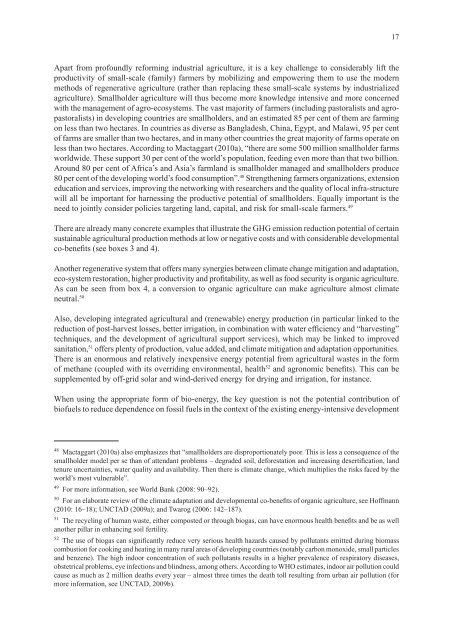Assuring Food Security in Developing Countries under the - Unctad
Assuring Food Security in Developing Countries under the - Unctad
Assuring Food Security in Developing Countries under the - Unctad
You also want an ePaper? Increase the reach of your titles
YUMPU automatically turns print PDFs into web optimized ePapers that Google loves.
Apart from profoundly reform<strong>in</strong>g <strong>in</strong>dustrial agriculture, it is a key challenge to considerably lift <strong>the</strong><br />
productivity of small-scale (family) farmers by mobiliz<strong>in</strong>g and empower<strong>in</strong>g <strong>the</strong>m to use <strong>the</strong> modern<br />
methods of regenerative agriculture (ra<strong>the</strong>r than replac<strong>in</strong>g <strong>the</strong>se small-scale systems by <strong>in</strong>dustrialized<br />
agriculture). Smallholder agriculture will thus become more knowledge <strong>in</strong>tensive and more concerned<br />
with <strong>the</strong> management of agro-ecosystems. The vast majority of farmers (<strong>in</strong>clud<strong>in</strong>g pastoralists and agropastoralists)<br />
<strong>in</strong> develop<strong>in</strong>g countries are smallholders, and an estimated 85 per cent of <strong>the</strong>m are farm<strong>in</strong>g<br />
on less than two hectares. In countries as diverse as Bangladesh, Ch<strong>in</strong>a, Egypt, and Malawi, 95 per cent<br />
of farms are smaller than two hectares, and <strong>in</strong> many o<strong>the</strong>r countries <strong>the</strong> great majority of farms operate on<br />
less than two hectares. Accord<strong>in</strong>g to Mactaggart (2010a), “<strong>the</strong>re are some 500 million smallholder farms<br />
worldwide. These support 30 per cent of <strong>the</strong> world’s population, feed<strong>in</strong>g even more than that two billion.<br />
Around 80 per cent of Africa’s and Asia’s farmland is smallholder managed and smallholders produce<br />
80 per cent of <strong>the</strong> develop<strong>in</strong>g world’s food consumption”. 48 Streng<strong>the</strong>n<strong>in</strong>g farmers organizations, extension<br />
education and services, improv<strong>in</strong>g <strong>the</strong> network<strong>in</strong>g with researchers and <strong>the</strong> quality of local <strong>in</strong>fra-structure<br />
will all be important for harness<strong>in</strong>g <strong>the</strong> productive potential of smallholders. Equally important is <strong>the</strong><br />
need to jo<strong>in</strong>tly consider policies target<strong>in</strong>g land, capital, and risk for small-scale farmers. 49<br />
There are already many concrete examples that illustrate <strong>the</strong> GHG emission reduction potential of certa<strong>in</strong><br />
susta<strong>in</strong>able agricultural production methods at low or negative costs and with considerable developmental<br />
co-benefits (see boxes 3 and 4).<br />
Ano<strong>the</strong>r regenerative system that offers many synergies between climate change mitigation and adaptation,<br />
eco-system restoration, higher productivity and profitability, as well as food security is organic agriculture.<br />
As can be seen from box 4, a conversion to organic agriculture can make agriculture almost climate<br />
neutral. 50<br />
Also, develop<strong>in</strong>g <strong>in</strong>tegrated agricultural and (renewable) energy production (<strong>in</strong> particular l<strong>in</strong>ked to <strong>the</strong><br />
reduction of post-harvest losses, better irrigation, <strong>in</strong> comb<strong>in</strong>ation with water efficiency and “harvest<strong>in</strong>g”<br />
techniques, and <strong>the</strong> development of agricultural support services), which may be l<strong>in</strong>ked to improved<br />
sanitation, 51 offers plenty of production, value added, and climate mitigation and adaptation opportunities.<br />
There is an enormous and relatively <strong>in</strong>expensive energy potential from agricultural wastes <strong>in</strong> <strong>the</strong> form<br />
of methane (coupled with its overrid<strong>in</strong>g environmental, health 52 and agronomic benefits). This can be<br />
supplemented by off-grid solar and w<strong>in</strong>d-derived energy for dry<strong>in</strong>g and irrigation, for <strong>in</strong>stance.<br />
When us<strong>in</strong>g <strong>the</strong> appropriate form of bio-energy, <strong>the</strong> key question is not <strong>the</strong> potential contribution of<br />
biofuels to reduce dependence on fossil fuels <strong>in</strong> <strong>the</strong> context of <strong>the</strong> exist<strong>in</strong>g energy-<strong>in</strong>tensive development<br />
48 Mactaggart (2010a) also emphasizes that “smallholders are disproportionately poor. This is less a consequence of <strong>the</strong><br />
smallholder model per se than of attendant problems – degraded soil, deforestation and <strong>in</strong>creas<strong>in</strong>g desertification, land<br />
tenure uncerta<strong>in</strong>ties, water quality and availability. Then <strong>the</strong>re is climate change, which multiplies <strong>the</strong> risks faced by <strong>the</strong><br />
world’s most vulnerable”.<br />
49 For more <strong>in</strong>formation, see World Bank (2008: 90–92).<br />
50 For an elaborate review of <strong>the</strong> climate adaptation and developmental co-benefits of organic agriculture, see Hoffmann<br />
(2010: 16–18); UNCTAD (2009a); and Twarog (2006: 142–187).<br />
51 The recycl<strong>in</strong>g of human waste, ei<strong>the</strong>r composted or through biogas, can have enormous health benefits and be as well<br />
ano<strong>the</strong>r pillar <strong>in</strong> enhanc<strong>in</strong>g soil fertility.<br />
52 The use of biogas can significantly reduce very serious health hazards caused by pollutants emitted dur<strong>in</strong>g biomass<br />
combustion for cook<strong>in</strong>g and heat<strong>in</strong>g <strong>in</strong> many rural areas of develop<strong>in</strong>g countries (notably carbon monoxide, small particles<br />
and benzene). The high <strong>in</strong>door concentration of such pollutants results <strong>in</strong> a higher prevalence of respiratory diseases,<br />
obstetrical problems, eye <strong>in</strong>fections and bl<strong>in</strong>dness, among o<strong>the</strong>rs. Accord<strong>in</strong>g to WHO estimates, <strong>in</strong>door air pollution could<br />
cause as much as 2 million deaths every year – almost three times <strong>the</strong> death toll result<strong>in</strong>g from urban air pollution (for<br />
more <strong>in</strong>formation, see UNCTAD, 2009b).<br />
17

















